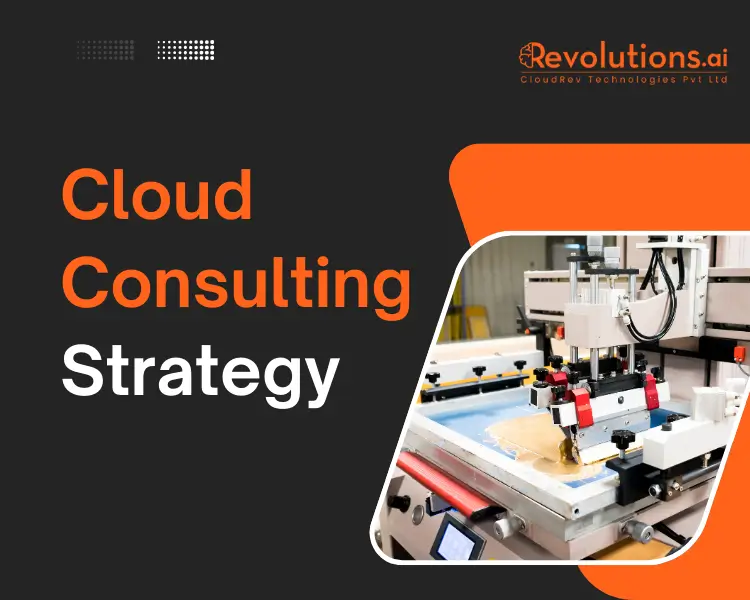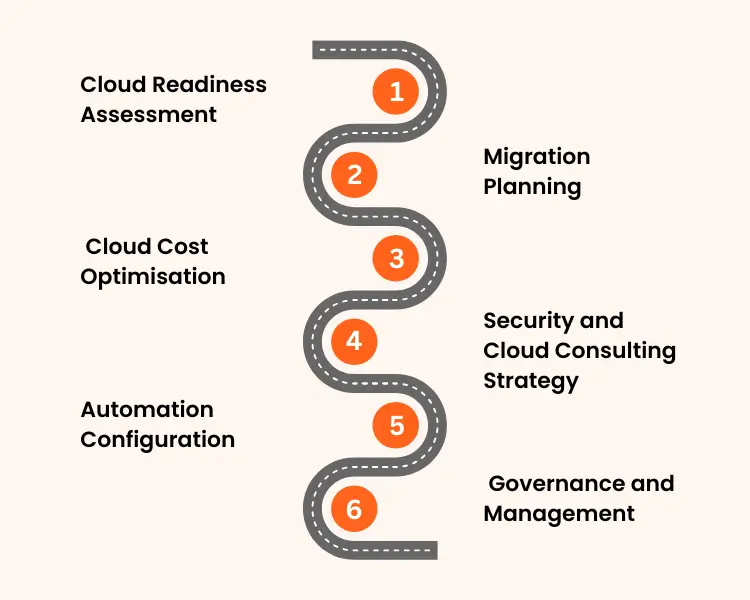Staring out into the cloud but having no idea where to begin or even how to begin doing it all for your business? You’re not alone. Whether you’re breaking away from legacy infrastructures, growing with multi-cloud deployments, or just want to be more agile, a quality cloud consulting strategy will make or break the whole ride. It’s not always about provider choice; it’s more about laying your cloud steps against concrete business goals.
With this digital age advancing so fast, just migrating to the cloud is not enough. You need a roadmap for all the areas, planning and security, right up to governance and automation. A good consulting strategy does not just see you through migration; it sees you migrate to a new, modernised infrastructure, install the proper tools, and create an infrastructure that scales up with you.
This blog walks you step-by-step through how to do it exactly. From setting goals to optimising long-term ROI, we’re going to walk you through the stages of a quick cloud consulting methodology that not just gets you up and running, but keeps your momentum constant. Let’s turn cloud buzzwords into action.
How Does a Cloud Consulting Strategy Support and Align With Overall Business Goals?
Cloud strategy can never exist in isolation; it has to be an enabler of more business objectives. From propelling agility and reducing the cost of infrastructure to facilitating innovation and upgrading customer experience, a clear-cut strategy justifies cloud investment with measurable outcomes. It is not about moving workloads around about getting the most out of technology in achieving growth, velocity, and resilience.
Aligning cloud projects with business targets starts with a complete understanding of what they are. Is it for enabling quick growth, remote work, or legacy modernisation? Clearness of goals determines the platform chosen, deployment strategy, and use of resources. IT and business stakeholders will interact constantly upfront, resulting in a more integrated, scalable, and successful outcome.
A great cloud migration strategy consulting model puts its focus on every phase, starting with architecture design to operational deployment. It connects every infrastructure choice with the most critical performance metrics like time-to-market, uptime, cost per transaction, and security of data. Where outcome is more important than activity in driving strategy, cloud adoption is a business growth driver.
What are the Common Cloud Strategy Services in Cloud Adoption?
Cloud adoption is not plug-and-play; there’s a thoughtfully designed path with a lot of puzzle pieces that can be rearranged. Businesses rely on cloud strategy consulting services to help them navigate effective, scalable, and secure migration tied to their unique needs.
1. Cloud Readiness Assessment
The service is evaluating current infrastructure, workloads, and business needs to determine if the cloud is right. It identifies technical deficits, risk, and opportunity, allowing organisations to determine when and how to go forward.
2. Migration Planning
Apart from the selection of a cloud provider, this stage defines how applications and data are to be migrated, in what sequence, and with what dependencies. Consultants aid in limiting disruption and ensuring performance levels are achieved en route.
3. Security and Cloud Consulting Strategy
Security is not an option, but it’s critical. This service makes sure the new cloud infrastructure meets regulations such as GDPR or HIPAA, and enforces role-based access, encryption, and incident response plans.
4. Cloud Cost Optimisation
Paying too much in the cloud is easy without guardrails. Also, cost optimization services help organisations make smart choices on pricing models, monitor usage, and scale automatically to eliminate wasteful expenses.
5. Automation Configuration
All this is about the integration of CI/CD pipeline configuration and monitoring, and logging solutions. Automation speeds up deployment, reduces human error, and offers ongoing service refinement after migration.
6. Governance and Management
Once migrated to the cloud, organisations require guardrails to navigate this process. Governance services encompass usage tracking, role management, policy enforcement, and performance monitoring to offer operational excellence.
How Does Multi-Cloud Architecture Influence Scalability?
Scalability is likely the most compelling reason for moving to the cloud, and multi-cloud architecture pushes that agility to new limits. With workloads distributed across several cloud vendors, companies can eliminate a single point of failure, preclude vendor lock-in, and scale the components independently. That translates into better resource utilisation and more performance peaks and valleys to soak up.
Organisations may attain best-in-class price and performance with a well-designed multi-cloud strategy. Some examples include deploying latency-sensitive applications on near-end-user providers and compute-intensive applications on providers that offer better prices. The dynamic deployment model is best suited for organisations that have differing and dynamic requirements.
A great Cloud consulting strategy provides scalability not compromising complexity. Consultants utilise governance policies, cloud-native application development, and cross-platform orchestration technologies to make multi-cloud architecture scalable, robust, and manageable.
How Does Disaster Recovery Upgrade with Cloud Services?
Traditional disaster recovery practices typically involve expensive on-premise hardware and long recovery windows. In contrast, cloud-based disaster recovery simplifies and automates the process while significantly reducing costs. By replicating critical systems and data across geographically distributed sites, cloud DR ensures minimal disruption during outages or failures.
Cloud providers offer high-availability zones and redundant data centres with real-time replication and fast failover capabilities. Recovery Point Objectives (RPO) and Recovery Time Objectives (RTO) can be met reliably, even in cases of system corruption or full data centre failures. Auto-scaling and load balancing further enhance fault tolerance and business continuity.
With expert Cloud integration services, organisations can implement predictive DR strategies instead of reactive ones. For instance, a global financial services firm facing recurring downtime transitioned to a cloud-native DR setup using AWS and Azure. The result? RTO dropped from 4 hours to under 15 minutes, standards were easily met, and operational DR costs fell by 40%. Also, For more insights, check out the Revolutions AI Blogs.
What Makes a Cloud Strategy Resilient and Scalable for the Future?
A future-proof cloud strategy is long-term, fact-based, and forward-looking digital transformation goal-oriented. It doesn’t merely respond to the requirements of today, it looks ahead to transform and build in flexibility.
- Flexibility- It needs to operate on numerous platforms, architectures, and tools so communities can innovate without re-inventing essential systems.
- Security-First Design- From access management to zero-trust architecture, an innovative approach has security as a fundamental element, not an afterthought.
- Automation Everywhere- Through CI/CD pipelines, infrastructure as code, and intelligent monitoring, automation simplifies and is less susceptible to human mistakes.
- Business-Driven Objectives- Technologized is not the way; instead, business-outcome-driven objectives like speed-to-market, customer happiness, or cost savings.
- Scalable Data Infrastructure- Managing increasing amounts of data, analytics workloads, and AI/ML integrations becomes the priority of long-term planning.
- Smooth Integration Capabilities- Through Cloud implementation services, companies offer system compatibility among existing systems, third-party products, and the new system at no cost of rewriting.
Conclusion
Strategically positioned, cloud is not merely a technology shift; it’s a clarion call for digital transformation. An effective Cloud consulting strategy supports organisations in their seamless transition, successful deployment, and running elasticity with quantifiable outcomes. Across platform choice to security and scalability administration, strategic consulting fills the gap between cloud deployment and business value.
Revolution AI delivers expert-led cloud migration, modernisation, and continuous optimisation services tailored to business outcomes. By combining deep technical expertise with a strategic, business-first approach, we help enterprises build resilient, scalable, and future-ready cloud strategies. Ready to accelerate your cloud journey? Get a demo or talk to our cloud experts today and discover what’s possible with us
Frequently Asked Questions
A consulting strategy is a structured approach to planning, executing, and optimising cloud adoption tailored to specific business goals. It ensures that cloud investments align with operational needs, budget constraints, and long-term scalability.
Cloud consulting services help organisations modernise legacy systems, implement scalable infrastructure, and adopt automation practices. These services are crucial for building agile, data-driven environments that support rapid innovation and customer-centric solutions.
Cloud migration refers to moving data, applications, and systems from on-premises or legacy environments to the cloud. Cloud implementation goes beyond migration by configuring environments, integrating services, and optimising performance for sustained use.
Yes, effective cloud consulting helps identify cost-saving opportunities through optimised resource allocation, pay-as-you-go pricing models, and ongoing performance tuning. This ensures cloud spending is aligned with actual business usage and ROI.
The right partner offers deep technical expertise, proven industry experience, and a clear understanding of business needs. Look for firms that offer end-to-end support from assessment and planning to implementation and post-deployment optimisation.

Hemal Sehgal
Introducing Hemal Sehgal, a talented and accomplished author with a passion for content writing and a specialization in the blockchain industry. With over two years of experience, Hemal Sehgal has established a strong foothold in the writing world, c...read more




